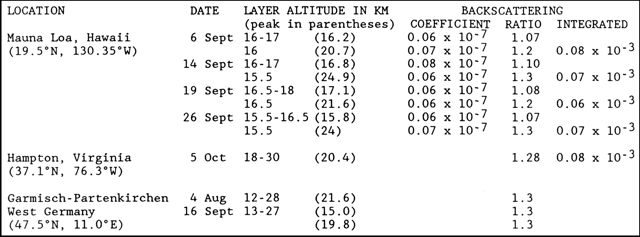Report on Atmospheric Effects (1980-1989) — September 1989

Atmospheric Effects (1980-1989)
Scientific Event Alert Network Bulletin, vol. 14, no. 9 (September 1989)
Managing Editor: Lindsay McClelland.
Atmospheric Effects (1980-1989) Continued minor lower stratospheric aerosol layer
Please cite this report as:
Global Volcanism Program, 1989. Report on Atmospheric Effects (1980-1989) (McClelland, L., ed.). Scientific Event Alert Network Bulletin, 14:9. Smithsonian Institution.
Atmospheric Effects (1980-1989)
All times are local (unless otherwise noted)
September lidar data from Mauna Loa, Hawaii (figure 70) continued to show minor aerosol enhancement in the lower stratosphere, perhaps from the 19 July explosion of Santiaguito, Guatemala. Lidar at Garmisch-Partenkirchen, West Germany also recorded a small increase near the base of the stratosphere on 16 September.
Inspection of data from NASA's SAGE satellite, which has a precessing orbit that was centered at 7-7.4°N on 19 July and 12.2-12.5°N the next day, revealed cloud layers at about 16 km altitude, near the tropopause. However, the 19 July SAGE data were collected before the explosion, and the layers had characteristics typical of cirrus clouds.
Information Contacts: Thomas DeFoor, Mauna Loa Observatory, P.O. Box 275, Hilo, HI 96720 USA; Horst Jäger, Fraunhofer-Institut für Atmosphärische Umweltforschung, Kreuzeckbahnstrasse 19, D-8100 Garmisch-Partenkirchen, West Germany; Mary Osborn, NASA Langley Research Center, Hampton, VA 23665 USA.

